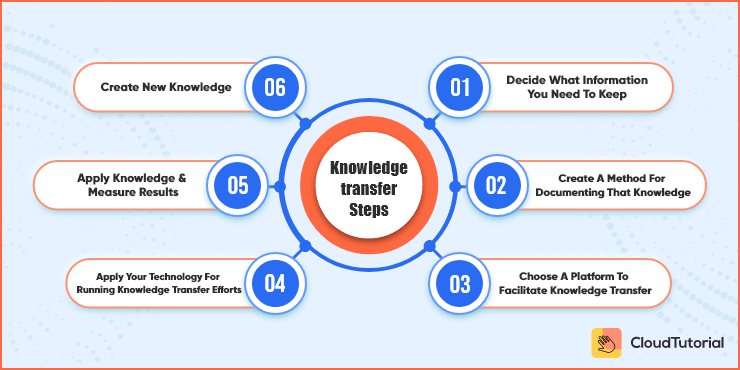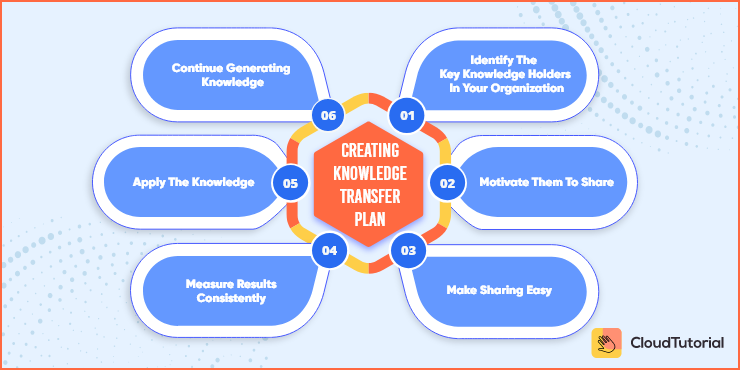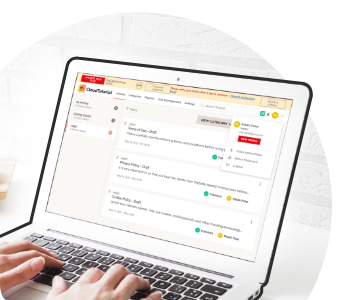How business goals are attained when your experienced employee leaves the organization? Ever wondered if there is any way to knowledge transfer from one employee to another? And how to proceed ahead?
A knowledge transfer template aids you in simplifying your knowledge which confirms that every team member has the data they require to keep your company running efficiently.
Let’s dive deep into these plans and templates that you can incorporate into your knowledge management system.
Table of Content
Knowledge Transfer Plans and Templates
-
Knowledge Transfer Template for Employees
Who is accountable for ensuring the knowledge is transferred within an organization?
Consider the scenario when employees, a valuable asset, leave the job for any specific reason, and the organization accepts their resignation. But what about the subject matter expert and the knowledge they possess?
- The organization needs to be ready with a successful knowledge transfer plan and new employees’ activities.
- So, what’s that plan? How can organizations transfer knowledge from old employees to new employees? Through knowledge transfer?
- Yes, you are right! Knowledge transfer through a template. The template allows old employees to transfer knowledge and exchange information to new employees who have joined the company.
Here’s one example of a knowledge transfer document template that you can download.
In this template, you will find a list of questionnaires that help your employees to transfer knowledge in a well-defined manner. Usually, the organization maintains this template to smoothly practice the running tasks and activities to recover from knowledge loss efficiently.
-
Knowledge Transfer Plan Template for University
The following sample knowledge transfer plan template in our list is for universities
Academic organizations typically use theoretical and practical approaches to identifying barriers and facilitators of the knowledge transfer systems. The primary goal of creating a knowledge transfer template is to gain leadership skillsfor academic purposes.
Teaching and non-teaching members can download this template to transfer their knowledge to the new individuals.
The template includes important information about the questionnaires that exist for the university. In addition, it contains the knowledge repository information related to transferred knowledge within the university.
-
Knowledge Transfer Template for Clerk Certification Class Credit
This knowledge transfer template word allows the individuals to share the expertise and experiential knowledge they possess within the organizational context. It also provides a list of questionnaires related to their working experience.
By answering a few questions, the organization’s experts can quickly grab the opportunities to transfer different kinds of knowledge to the right people in the best way.
Here’s the sample template that you can download and get the idea.
-
Knowledge Transfer Document Template for SMEs
Small and medium enterprises use the knowledge transfer templates to share the information and knowledge with new employees..
- It is one of the best methods to deal with multiple types of knowledge easily shared in SMEs’ knowledge transfer programs.
- An individual or developers in SMEs can easily use this knowledge transfer document template and share vital code and its instructions related to their project.
Employees of small and medium-sized businesses can download this sample template and get the idea.
Essential Steps To Perform Knowledge Transfer
Here we will share the best practices to transfer knowledge.

Decide What Information You Need To Keep
Depending on the business needs, employees first need to identify the information that other people search for nowadays. The information usually comes in many forms ranging from necessary metrics like getting customer logs to responding to customer’s complex queries.
You can enhance the performance of an organization’s culture by considering the following metrics of effective transfer of organizational knowledge:
- Brainstorming leads to a new idea
- Work shadowing
- Learning new impressive leadership skills
- Organizing expert sessions
- Fetching the solution to complex issues
- Developing new projects
Create A Method For Documenting That Knowledge
Where does the organization or a team member save the information?
A knowledge transfer plan Excel sheet, Word document, and even Powerpoint presentation can be easily saved to our local or cloud system. But it’s not the same for company knowledge acquisition. Instead, you need to define a specific process for such a case.
- For example, the documentation of the customer service call is a very tedious and impossible process. Therefore, the best recommendation is to use techniques like recording audio and video calls.
- On the other hand, it becomes evident that using various types of media like images, videos, and graphical representation in the related content becomes more comfortable for the reader to understand.
- The company must follow an effective knowledge transfer plan template for its employees in a specified format. The primary cause behind it is that the employees must know when and where the information must be saved for future purposes.
Choose A Platform To Facilitate Knowledge Transfer
Now, you are ready with the information that you want to retain. The next step is to identify the technology that you need to apply to your working system. Employees are not part of this knowledge transfer strategy.
- Most organizations fail to preserve the knowledge within. Why? It’s because they rely on the employees to determine what and where to save the information.
- Moreover, they provide appropriate training for such processes and inform them to use tools like Google Drive or Sharepoint, which are somewhat disorganized.
Is there any specific platform that supports knowledge transfer?
Yes, there is a platform that supports knowledge transfer.
It is CloudTutorial, a knowledge-sharing platform that can fulfill all your business needs. Compared to other knowledge management software, it is flexible for any industry. This platform helps in:
- Creating FAQ sites with ease
- Sharing information through user manuals, guides, and release notes
- Creating SOP for the organization
- Supporting knowledge-base articles
- It makes the knowledge transfer program very seamless
With its help, knowledge transfer activities will be aligned across teams and will aid them greatly. It will make the day-to-day decision-making process easier for the teams.
Apply Your Technology For Running Knowledge Transfer Efforts
The company’s critical knowledge is ever-growing, and for that particular reason, the knowledge transfer process reflects the most.
- Planning is essential before implementing the process to transfer knowledge in effective knowledge management research and strategy.
- Any organization needs to adopt the right technology and platform for knowledge sharing to gain colossal potential for enhancing business performance.
- Apart from creating documentation, the organization should allow the employees to regularly use the interactive tool to search for the right information they need.
- Tools with Q&A and robust search help employees deal with subject matter experts efficiently. These experts will not have to answer similar questions repeatedly.
- A large number of customer support to keep the knowledge alive makes the perfect knowledge-sharing platform.
Apply Knowledge & Measure Results
Now, the time has come to apply the knowledge and wait for its impressive outcomes.
- The organization uses appropriate knowledge management tools in different areas to measure its succeeding values across multiple key performance indicators (KPIs).
- Consider the scenario where the knowledge that is to be shared is possibly related to the solution of a complex business issue. A valued member must be given a priority task to perform the problem-solving capabilities and publish reports on the results generated.
- Hubspot and Pipedrive are the best examples that can easily track the tasks, set the benchmarks, and identify your application measures. You can achieve great success if knowledge is being used at the right time and perfect place.
Create New Knowledge
Do you or team members in the organization have their idea of implementing specific knowledge or information?
- Just go ahead and start working on knowledge management’s best practices for other organization areas. If your luck is good and the results are coming quite interesting, then a new way of innovation in knowledge transfer occurs for the long term.
- If your organization has a perfect and effective knowledge transfer system, there is no need to worry about implementing new ideas and business problem-solving capabilities.
So, we shared the best practices to transfer knowledge. Now, we will show you how to create a knowledge transfer plan for your organization in the next section.
Create a Knowledge Transfer Plan for Your Business

A robust knowledge transfer plan typically differs from business to business, no matter size, and shape. However, certain things need to be taken into consideration before moving to implement the knowledge transfer.
A robust knowledge transition plan template typically differs from business to business, no matter size and shape. However, certain things need to be taken into consideration before moving to implement the knowledge transfer.
Identify the Key Knowledge Holders in Your Organization
No one in this world is perfect, but the working experience makes an individual perfect. It is the organization’s responsibility to search for one person that holds the correct knowledge for your business needs.
Motivate Them to Share
Motivation is the key to the success of your organization. And such stimulation enhances the idea of knowledge transfer professionals who work within the organization to share their knowledge. Provide them with the experience of using the various platforms in their working culture.
Make Sharing Easy
Sharing knowledge within and outside the organization must be smooth. We just need to make sure that the team members have access to fast and easy-to-use tools.
Measure Results Consistently
For businesses to achieve great success to the next level, they must set standards and benchmarks, track the project’s status, and finally must have the ability to communicate the results to other team members.
Apply the Knowledge
Whether small or big, whatever knowledge is available, start implementing it; another option that the organizations must-try is providing incentives to the junior and senior employees, which bring motivation to team members.
Continue Generating Knowledge
Knowledge sharing must be available in any form, whether through industry experts, formal training sessions, or even encouraging community forums to share knowledge or company information with the employees. Always be ready to share information in order to enhance business performance, innovation, and collaboration in your organization.
Tacit knowledge is the knowledge that comes from a person’s experiences and context. It’s information that, if asked, would be the most difficult to write down, articulate, or present in tangible form. The tacit knowledge is transferred using the following ways:
- Using collaboration and social networks
- Show your work
- Storytelling
- Guided experience
- Tracking lessons learned
- Reinvention
THere are some ways for effective knowledge transition within your company:
- Guided experience
- Work shadowing
- eLearning and instructor-led training
- Paired work
- Mentorship. Long or short-term mentorship is an excellent way to share information between two people in the company.
Here, we have seen a list of plans and templates specifically for employees, universities, clerk certification, and SMEs. If you are looking to integrate knowledge transfer tools for your business, then you must adopt CloudTutorial.
This standalone KM software has the required features and functionalities that help you create an advanced knowledge base for your company. By including a perfect template in your company culture to share the knowledge, the organ
Try it out before you decide.
Create a test article NOW!
Using this tool, all you have to do is add your first test article and see how it looks. Now, you don’t have to sign-up or login into CloudTutorial software just to check how your first article appears.


